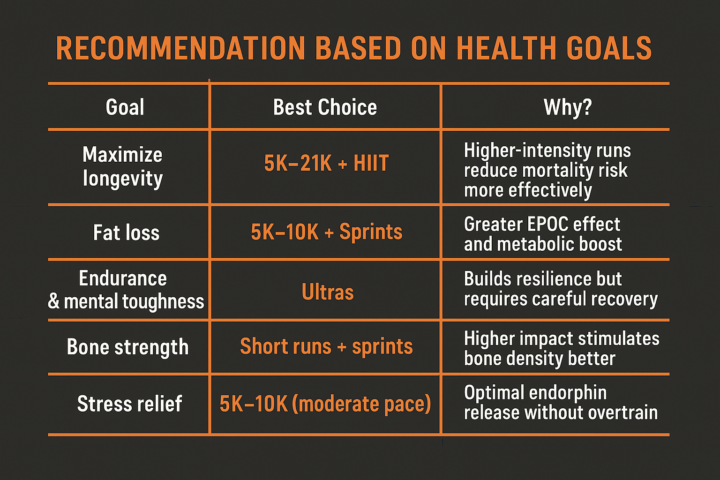Activity
Mon
Wed
Fri
Sun
Jan
Feb
Mar
Apr
May
Jun
Jul
Aug
Sep
Oct
Nov
Dec
What is this?
Less
More
Memberships
The Storyteller's Path
295 members • Free
14 contributions to Better Runner
Ultras Vs. Long Distance running
📜Long-distance running, or endurance running, is a form of continuous running over distances of at least 3 km (1.9 mi) Did you know that? You don't have to run an ultra or a marathon to name yourself long- distance runner. 🌄 So what I want to talk about is the benefits of different running disciplines for our health, fitness and longevity. If you are thinking about running as a tool to improve these, I have put together some facts to help you. 💭 Cardiovascular & Longevity Benefits 💖 Shorter Distances (5K–21K) - Improves VO₂ max through speedwork, intervals, and tempo runs. - Boosts heart efficiency via high-intensity bursts. - Promotes stronger cardiovascular adaptation in less time. Ultra-Running: - Builds aerobic endurance over long durations. - Caution: Prolonged running may increase oxidative stress and cardiac strain in some, though research varies. - Less effective for VO₂ max improvement than speed-focused training. 🔥 Metabolic & Weight Management Shorter Distances (5K–21K) - HIIT and tempo runs trigger EPOC (afterburn), burning more calories after the workout. - More effective for fat loss due to higher intensity and hormonal response. - Boosts insulin sensitivity and metabolic rate. Ultra Running - Promotes fat oxidation as the primary fuel source. - Improves metabolic flexibility, especially in fasted or low-carb states. - ⚠️ May elevate cortisol (stress hormone) if recovery isn’t sufficient, which can hinder weight loss and cause fatigue. 🦴 3. Musculoskeletal & Injury Risk Shorter Distances (5K–21K) - Lower risk of injury due to less repetition and impact. - Speedwork (like hill sprints) applies bone-loading stress, stimulating bone density (Wolff’s Law). - Good for long-term joint health if done with proper form. Ultra Running - Higher risk of overuse injuries (e.g., tendinitis, stress fractures) due to long, repetitive impact. - Common strain points: knees, hips, feet. - Well-trained ultra-runners often adapt, but recovery and conditioning are crucial.

We Start NUTRITION Awareness Challenge🥑👨🍳
I want to touch on the most important topics. The foundation of running performance. I tell you - fixing your diet will fix everything in your life. NOT just running performance, but overall fitness, hormonal health, energy levels and as a result raise self-esteem, reduce stress, fix relationships. We all want to feel great. If you don't have health, how can you think about money? Business? Relationships? They will all become toxic and disappointing. So be good to yourself and start building this foundation brick by brick NOW. ❗IF YOU FEEL THAT ANY OF THIS RELATED TO YOU❗ 📛I’m Always Tired on Runs 📛I Train hard but don't see any progress 📛I Run but Don’t Lose Weight 📛I Get Hungry All the Time! 📛Recovery Takes Forever 📛I Don’t Know What to Eat Before/After Runs 📛I Eat ‘Healthy’ but Still Feel Sluggish 📛I Stress-Eat After Hard Runs 📛I’m Confused About Supplements vs. Real Food 📛I Need Accountability to Eat Better Then there is a high chance that your diet is flawed and needs to be reviewed ✅ Dieting is not just following a plan for 1 week, 1 month or 1 year. It is a complex habit that starts with knowledge and ends as a lifestyle. 1️⃣Knowledge ➡️ Learning habit ➡️Repetition ➡️ Lifestyle 🎯 So I want help you get the right knowledge, tools to understand your diet and become healthy, energized and look amazing! 🐈 THIS CHALLENGE WILL INCLUDE WEEKLY CALLS so we all share our wins and failures along the way, ask questions and learn together 🤗 Week 1: Awareness & Tracking Theme: "Know Your Plate – Understanding Macros & Current Habits" 🕛START : 7 Aprill Stay tuned✅

March Challenge WINNER 🏆
CONGRATULATIONS to @Kristy Kelley , our challenge winner who crushed 32 hours of running in March—that’s more than 1 hour per day! 🚀🔥 Your dedication is next-level, especially knowing that you training for an ultra. As a reward, I’m thrilled to offer you a free month of coaching—we’ll tailor sessions to your schedule and goals. Let’s make those ultra dreams unstoppable!💘 Keep pushing limits, and stay tuned for the next challenge!🏋️♀️

Restless legs after a long run?
Maybe I am weird, but my legs don't seem to want to stop moving after my long runs. I did 26 miles on Saturday. It was a slow but comfortable run. Of course, I was exhausted by the time I was finished. But when I sat down to relax, my legs just wanted to fidget. I had a hard time sitting still. Even in bed that night, I just want to kick my legs. I have noticed this after other long runs in the past. Is this normal?

22-31 March Final Challenge Block
🏆 FINAL COUNTDOWN: Last Chance to Win 1 Month of FREE Coaching! The March Running Challenge is almost over, but there’s still time to push for victory! 🚀 🔥 Main Prize: 1 MONTH of FREE personalized running coaching with me!Whether you’re aiming for a new PB, prepping for a race, or just want to level up your running, this is your chance to get expert guidance and crush your goals this season. ❗I have noticed that not all of you updated tracker lately ❗ 🏅 Current Leaderboard (Top 3 by Duration – Last 3 Weeks): @Kristy Kelley @Kelly K @Aleksandra H Keep going girls - you are awesome!😍 💥 It’s Not Over Yet! Even if you’re not in the lead, a strong final push could change everything. Every run counts!

1-10 of 14
Active 2d ago
Joined Jan 4, 2025
INFJ
East Jordan, MI
Powered by


